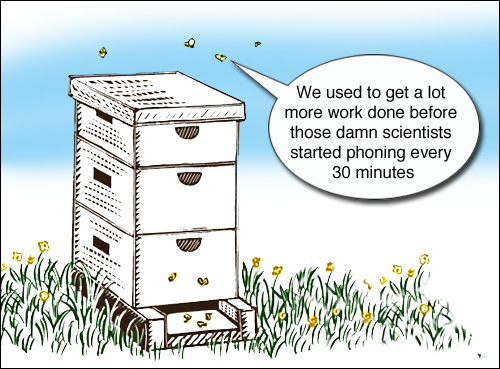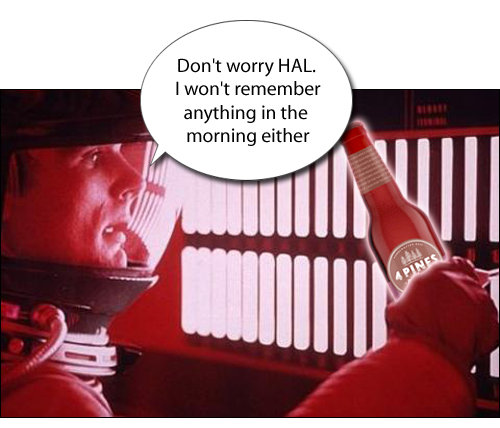OMG! ACOWLYTES!! Mobile phones are KILLING OUR BEES! The FOOD CHAIN is going to COLLAPSE and we’re ALL GOING TO DIEEEEEEEE!!!!!!
What’s that you say? That’s not news? You already heard it ages ago? Ah, yes, Faithful Acowlytes, the hoary old idea that bee Colony Collapse Disorder is caused by radiation from the cellphone network has, of course, been reported, sensationalized and thoroughly found to be wanting years ago, but that doesn’t stop it from rising once more like a zombie hopped up on homeopathy to chew on the brains of the stupid. Twice today I came upon this story, once in my local newspaper and once via a Facebook posting. Both times, the ‘accredited’ source was this credulous gaping by Inhabitat reporter Lori Zimmer.:
More Scientific Studies Indicate That Cell Phones are Harming Bees
Scientists may have found the cause of the world’s sudden dwindling population of bees – and cell phones may be to blame. Research conducted in Lausanne, Switzerland has shown that the signal from cell phones not only confuses bees, but also may lead to their death
The original title of this article was It’s Official – Cell Phones are Killing Our Bees (as you can still see in the story’s URL) but the editors have evidently been kicked soundly in the bollocks and told that it’s not actually official at all, at least unless your interpretation of the word ‘official’ is ‘I pulled it out of my ass’.
The Daily Mail carried the story as Mobile Phones ARE to Blame for Killing off the World’s Bee Populations as is nicely preserved in the digital amber that is the remnant Google search link: ((Ah, don’t we LOVE teh intertubes, where stupidity and duplicitousness is forever preserved!))

Presumably someone gave them a good swift kick in the testicles as well, since they have now amended it to: Why a mobile phone ring may make bees buzz off: Insects infuriated by handset signals.
So, what does the ‘research conducted in Lausanne, Switzerland’ actually show? Well, you can read the full text of researcher Daniel Favre’s findings here, if you’re so inclined, but, as is my wont, I have done the legwork for you.
M. Favre and colleagues have conducted an experiment that suggests that bees don’t really like active cell phones being close to them. That is THE SUM TOTAL of what they have found. To synopsize, M. Favre showed that when mobile phones were place directly underneath bee hives (that is, within mere centimeters of the bees living environment), and the phones were dialled, the bees acted strangely. Now, while this is very interesting, it is hardly surprising. It has been demonstrated that honeybees are at least aware of magnetic fields ((Daniel Favre says in his report: ‘It is known that honeybees possess magnetite crystals in their fat body cells and that they present magnetic remanence. These magnetite structures are active parts of the magnetoreception system in honey- bees. Importantly, it has been shown that honeybees can be trained to respond to very small changes in the constant local geomagnetic field intensity.’)) so there is a likelihood that they are also affected to some extent by electromagnetic radiation. We already know that cell phones emit electromagnetic radiation ((including microwave heat to some extent)) (that’s why almost all cell phone manufacturers advise you not to hold them close to your ears for long periods of time), so an educated speculation says that having a strong EM field radiating at them from centimeters away may well annoy them at least a little. M. Favre’s experiment tends to confirm this. THAT’S ALL.
What Daniel Favre’s trials explicitly don’t show is that the cell phone network in general (including its broadcast towers) has any effect on bees, or that, even if it did, that such an effect has anything at all to do with bee Colony Collapse Disorder. Journalists just made that shit up because their brains go like this: ‘Bees… oooh… cell phones… ooooh… sciency stuff… ooooh… COLONY COLLAPSE DISORDER IS OFFICIAL!!!
I don’t know who teaches journalists to think like this, but it is plain that it must be part of their training because so many of them do it. Here is a very funny cartoon from Zach Weiner’s Saturday Morning Breakfast Cereal that illustrates in pictures, a typical journalist-meets-science scenario: ((With thanks to Zach for generously allowing it to be linkable.))

But I digress. Back to the science…
Daniel Favre’s experiment is reasonably sound as far as I can tell – if the aim is to find out what bees do if you put a phone in their hive. His protocol seems reasonable, and his results appear to be methodically tabulated. Where he wanders a bit off track is his further hypothesizing, prompted, one has to speculate, by an already-formed agenda. In his own words (my emphasis):
“We should ask ourselves, whether the plethora of mobile phone masts also have an impact on the behaviour of the honeybeesâ€
To which I reply: Sure, let’s ask away, and while we’re at it, let’s also ask whether they have an impact on kangaroos, pigeons and water buffalo. Questions don’t cost anything. But for the question to have any meaning at all in relation to the experiment at hand, M. Favre has first to show that what mobile phones do when they receive and transmit calls is in some way relevant to the kind of behaviour that cell phone transmitter masts exhibit. ((Speaking personally, I don’t have a clue. For all I know, cell phone towers work in an entirely different manner to the way my iPhone does when they send and receive signals. Daniel Favre cannot just make an assumption that the two things are equivalent. Furthermore, as a scientist it is irresponsible of him to allow that assumption to colour the experiment in question, especially when he is presenting it to untrained minds. If he intends to make a case for cell phone towers having an effect on bees, he must show that cell phone towers are having an effect on bees, not simply demonstrate that an affiliated piece of technology has an effect on bees. Science is like that – it has strict and unforgiving expectations of thoroughness.)) This being established, he would then need to demonstrate that the signals are actually strong enough to affect bees. ((It’s kind of curious that it seems that, given his expressed concerns, M. Favre has conducted his phone experiments in an environment that was not actually isolated from the cell phone towers (‘Beehives were located either in the beekeeping and apiary school of the city of Lausanne (altitude, 749 m) or in a second site used by beekeepers north of the city of Morges (altitude, 510 m; both locations in Switzerland’). If the nominal ground state for ‘normal’ bee activity is taken to be one in which cell towers are present, then, ipso facto, the cell towers are not having any significant effect…)) Having done that, his next step would be to show how such an effect is related to bee Colony Collapse Disorder, if at all.
Do you see how that works, Acowlytes? There is no reason at all to suspect that cell phone networks play any part in CCD. It is a speculation that was raised years ago as one of dozens of possibilities and has, for some reason, fired up the paranoid fantasies of the media and the brainless. For it to gain any ground at all, numerous pieces of a a puzzle must be locked together in such a way that they make sense. To put it another way, why cell phone radiation in particular? Why not rising C02 levels, increasing UV levels, increasing ambient noise, decreasing night-time sky visibility or any of a thousand other things?
Daniel Favre knows this. In his own words, again:
“Among other factors such as the varroa mite and pesticides, signals from mobile phones and masts could be contributing to the decline of honeybees around the world ; I am calling the international scientific community for more research in this field. â€
Once more, I’ve emphasized the points that you should attend. I think it’s pretty clear that M. Favre is in no way putting his conclusions forward as ‘official’. And what he doesn’t say, but should know if he’s doing research in this field, is, that among apiarists and scientists, pretty much every other speculated reason for CCD is considered more likely than cell phone signal radiation. In fact, it is beginning to appear that the number one contender for Colony Collapse Disorder is our love for convenience and the satisfaction of our cravings at a cheap price. In other words, the thing that is most likely killing off the bees is our creation of a vast honeybee monoculture. Hives are weakened by expedient farming practices and a lack of genetic diversity and so become highly susceptible to environmental stressors such as pathogens, pesticides and parasites. A recent USDA report says:
…based on an initial analysis of collected bee samples (CCD- and non-CCD affected), reports have noted the high number of viruses and other pathogens, pesticides, and parasites present in CCD colonies, and lower levels in non-CCD colonies. This work suggests that a combination of environmental stressors may set off a cascade of events and contribute to a colony where weakened worker bees are more susceptible to pests and pathogens.
So, while we may well be responsible for the collapse of the honeybee population (a population that we made unnaturally big in the first place) it’s not because we’re making phone calls. It’s just because we want something sweet and cheap for our toast at breakfast.
That, however, does not make for a much of a paranoia-inducing headline for the idiotic news media. And selling papers, is, after all, MUCH more important than giving people the facts.

















